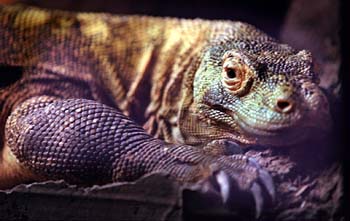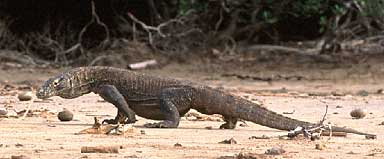

Source of Image Source of Image
Notes for Chapter 28: Reptiles
Click link to return to Lecture
Schedule
or back to Chapter 27
or ahead to Chapter 30
Chapter 28 Assignment:
559-571, 576-579; RQ-28: 2-5, 7, 10, 16-17
Then: Ch. 30: 609-621, 624-626, 634-639;
RQ-30: 1-2, 6-8, 11, 15-16 (last two lectures)
Introduction: Enclosing the Pond


Source
of Image Source
of Image
Featured Animal: Komodo
lizard (Komodo dragon)
More Links: 1
- 2 - 3
- 4 - 5
- 6 - 7
- 8
- 9
The amnion and amniotic egg
Frog: Lizard:
many eggs laid in water Fewer
eggs laid on land
fully aquatic larval stage no
larval stage
metamorphosis to develops
directly to
juvenile juvenile
sexually mature adult sexually
mature adult
mates in water mates
on land
external fertilization copulation
amniotic egg - embryo plus extraembryonic layers
(see pp. 171-172)
amnion is fluid-filled sac that protects embryo
yolk sac provides food
allantois gathers waste
chorion surrounds all the other layers
egg is enclosed in semi-permeable shell
Leading hypothesis of amniote relationships
(see cladogram Fig. 28-2)
Amniota
Synapsida
various extinct lineages
Mammalia
Sauropsida (or Reptilia w/ birds included)
turtles (although molecular studies suggest
archosaur affinities)
Diapsida
Lepidosauria
Sphenodon
(the tuatara)
squamates
(lizards incl. snakes)
various
extinct marine reptiles such as ichthyosaurs
Archosauria
crocodiles
pterosaurs,
dinosaurs (incl. birds)
Next lecture:
Dinomyths
1. Dinosaurs are big lizards
2. Dinosaurs were all big extinct reptiles
3. Dinosaurs had a sprawling stance
4. Dinosaurs were all big
5. The largest dinosaurs lived in swamps
6. T. rex ate Brachiosaurus
7. Dinosaurs dragged their tail
8. Dinosaurs were cold-blooded and sluggish
9. Dinosaurs were stupid
10. Dinosaurs went extinct
1. Dinosaurs are big lizards
actually are closer to crocodiles
think birds (see cladogram on p. 585)
2. Dinosaurs were all big extinct reptiles
pterosaurs are sister taxon of dinosaurs
ichthyosaurs, etc. are nearer to lizards
pelycosaurs (e.g., Dimetridon) are nearer to mammals
3. Dinosaurs had a sprawling stance
instead had fully upright stance
synapomorphy: hip socket has central hole,
hind limbs directly under body, swing fore-aft
(other archosaurs have solid hip socket and sprawling stance)
not necessarily faster, but better endurance
because movement doesn't constrict the lungs
4. Dinosaurs were all big
earliest dinos (240 mya) were small
more recent dinos as small as hummingbirds
5. The largest dinosaurs could only support their body weight in swamps
an elephant would sink in the mud
more likely lived in savanna-like habitat
6. T. rex ate Brachiosaurus
T. rex was over 70 million years later
T. rex did not live together with cavemen
7. Dinosaurs dragged their tail
probably held it upright as in T. rex
8. Dinosaurs were cold-blooded and sluggish
some were slow (ectothermic)
others were possibly warm-blooded (endothermic)
9. Dinosaurs were stupid
active predators are often cunning
evidence for nesting and mating behavior
10. Dinosaurs went extinct
many did, but not birds
birds are dinosaurs, reptiles, vertebrates
conventional "dinosaurs" is paraphyletic because
it excludes birds
there are more living species of birds than mammals
The following outline of lecture notes does not follow Ch. 28 headings.
Also note, the text cladogram figures have some problems. Here are more details.
Click link to return to Lecture
Schedule
or back to Chapter 27
or ahead to Chapter 30
This page created 11/13/01 © D.J. Eernisse, Last Modified 11/13/01, Links Last Completely Checked 11/13/01